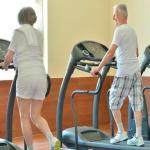Compression Hosiery: Clearing Up The Confusion
The aches and pains associated with ageing are unfortunately, inevitable - whether these derive from a generic lack of wellbeing or are borne of a specific condition. There’s always a pill or potion we can take to alleviate pain, however there’s a certain pleasure in being able to relieve ourselves of this naturally, without resorting to synthetic means. To this end, compression hosiery is gaining wider and wider recognition with regard to its functionality - even in the medical sphere - turning it from a holistic to a truly scientific remedy.
What is Compression Hosiery?
Compression hosiery in its essence works to encourage proper blood flow. Blood flows around our body but it is not always in a smooth manner; oftentimes it pools and doesn’t flow properly. Compression in its most basic form combats this, by its application of a firm, graduated pressure, which encourages the blood to flow properly again. Compression is measured in the unit mmHg, which means millimetres of Mercury.
What Ailments Can Compression Help With?
Reports of conditions that compression can help with that have been published over recent years include: sleep apnea, poor circulation, lipoedema, deep vein thrombosis, varicose veins, leg ulcers and general pain. It’s also thought to help with sports performance and there are even reports it can make us happier - one brand produced a range that puts pressure on the M6 vein in the body to encourage wellbeing.
Deciphering Compression
At the Leg-Care Company we have a lot of lovely elderly clients whom we help decide what on earth type, brand and level of compression they need - it can get feel complicated if you’re not familiar with the terminology. We’ve got a handy guide on our website and the below advice for you to read to know exactly what level of compression you need for what ailment.
See below, our basic outline on what means what. Some conditions come up multiple times, but it depends on their grade and severity as to what level of compression you’ll require.
10-20 mmHg
This is the lightest level of compression available and you can use hosiery of this kind to treat/prevent:
- General fatigue in the legs
- Mild varicose veins (for example during pregnancy and those without significant oedema i.e fluid)
- Prevention of thrombosis and embolism during travel
20-30 mmHg
A slightly stronger level, use this for treatment of:
- More severe varicose veins during pregnancy and those with mild oedema
- Post superficial and deep vein thrombosis
- Post sclerotherapy (a treatment for varicose veins) and venous surgery
- Venous ulcers and CVI (chronic venous insufficiency – a condition whereby the valves in the leg veins do not work effectively)
- Prevention of DVT (deep vein thrombosis) and oedema
- Post-traumatic oedema
30-40 mmHg
This level provides a significant amount of compression, and is used to treat:
- Severe CVS (definition as above)
- Active or recurrent leg ulcers
- Lymphoedema (swelling of the legs resulting from poor lymphatic drainage)
- Severe post-traumatic oedema
>40 mmHg
This is the strongest grade of compression, for treatment of:
- Severe lymphoedema
Please note it is always advisable to speak to a Doctor, particularly when looking at those stronger levels of compression. If you’re unsure of what a condition means or what level of compression you need, we’re always happy to lend a helping hand and you can contact us in the UK on 01288 359 599 or find us at www.leg-care.co.uk.
With thanks to 101 Elder Care for giving us the opportunity to post on their blog.
Note: This is a sponsored post.
More to Read:
Previous Posts:
Next Posts:




